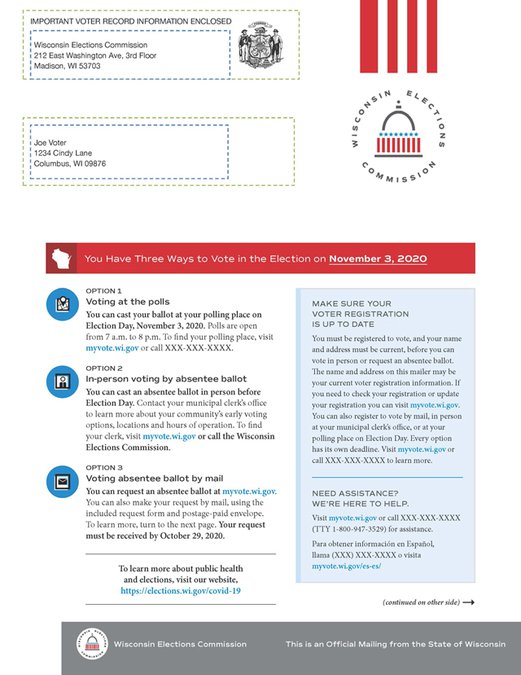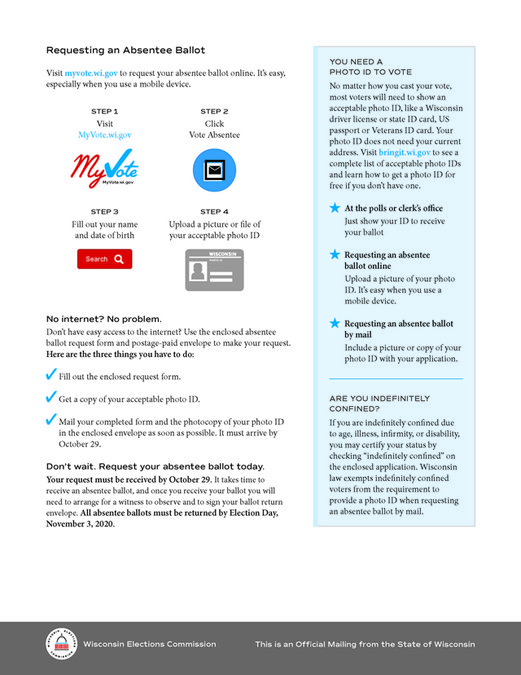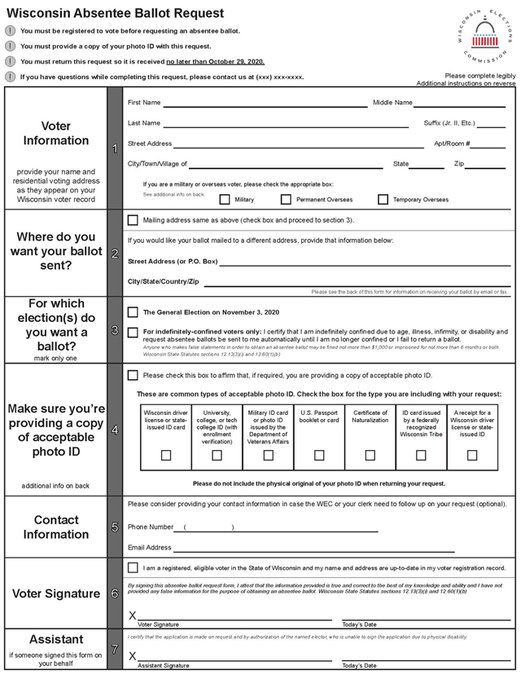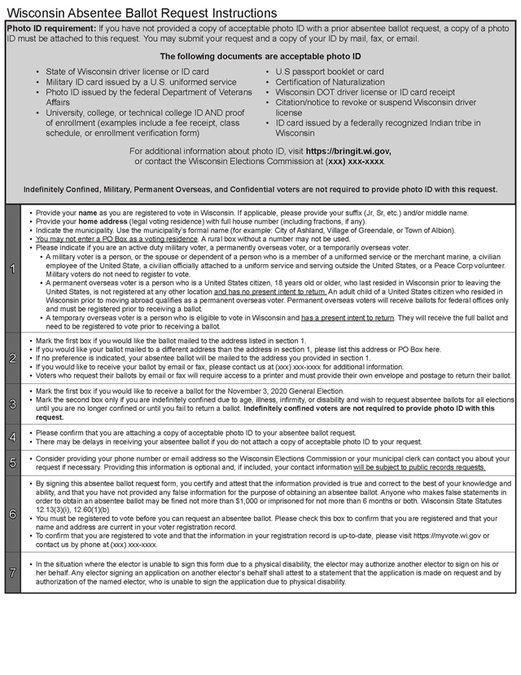WISCONSIN - Brinksmanship was on full display as the Wisconsin Election Commission (WEC) ran down to the wire on a decision about sending 2.7 million Wisconsin voters an absentee ballot mailing. The mailing would contain information and an application to vote absentee in the November 3, 2020 election.
According to WEC Administrator Meagan Wolfe, Wisconsin Department of Administration Printing & Distribution required the finalized piece to be provided to them no later than Friday, June 19. After failing to approve the mailing to go forward at their June 10 meeting, the WEC voted unanimously 6-0 at their June 17 meeting to approve the final draft of the letter and application.
“This will be a huge mailing, and will have to be printed in batches and stored in a climate controlled environment until it is time to send out the mailing on or around September 1,” Wolfe told the WEC. “DOA Printing & Distribution tells me it will require three semi trucks to hold all of the mailing pieces.”
Wolfe told the commission members that since the last meeting, her team had been able to conduct usability testing with the mailing pieces, and it had gone well.
“Almost all the feedback we received was that the language was very clear and helpful,” Wolfe said. “As a result, we are not recommending changes from a usability standpoint.”



Changes made
At the June 10 meeting, commission members provided feedback to WEC staff about changes they would like to see made to the letter and application before approving it. At the June 17 meeting, Wolfe presented the final draft and outlined how commission feedback had been incorporated.
Copy of Photo ID -in order to emphasize that an absentee ballot application could not be considered complete without a copy of or digital photo of an acceptable photo ID, WEC staff added language to the four steps outlined to apply. If submitting a paper application, it must be accompanied by a photocopy of an acceptable photo ID. If submitting the application online, the applicant must have a digital image of a valid photo ID ready to be uploaded. One common way to do this is to use a smart phone to take a picture of the front of a driver’s license, for instance. The image can be e-mailed to yourself, saved on your computer, and uploaded. The online application can also be completed using just the smart phone.
Affirming applicant is a registered voter– a check box was added to the form asking the applicant to affirm they are a registered voter. It is not necessary to check the box in order to submit a complete application, but since only registered voters are allowed to apply for an absentee ballot, there is no harm in choosing to check the box. It is also a way to emphasize that before you apply for an absentee ballot, you should verify that you are indeed registered to vote at myvote.wi.gov. If you are not registered, you can also register to vote online.



Discussion
Commissioner Dean Knudson (R-Hudson) commented that he was “pretty satisfied” with the changes which he saw as “helpful.”
“I am concerned, though, about the ‘Don’t wait. Request your ballot today,’ language at the bottom of page two of the letter,” Knudson said. “I think it should say that it must be received by 8 p.m. on October 29.”
Commission chair Ann Jadobs (D-Milwaukee) agreed with Knudson that specifying not only a date, but also the time, was a good idea.
Commissioner Bob Spindell (R-Milwaukee) questioned whether it would not be more proper to use the language ‘in-person absentee voting’ versus ‘early voting’ to describe that option.
Wolfe responded that her team had wrestled with that question, but had decided that ‘early voting’ was less confusing for the voter that ‘in-person absentee voting.’ Wolfe agreed that ‘in-person absentee voting’ was the most proper language.
Spindell also questioned the information on page one of the letter, in the ‘Option Three’ language which described requesting an absentee ballot. The language states that the ballot application must be received no later than October 29, 2020. According to Spindell, it should also state the time which is 5 p.m., and that it must be received either by the WEC or the voter’s local election clerk.
Spindell also took issue with the language in the ‘Indefinitely Confined Voter’ section of the letter.
“Shouldn’t there be a line for a signature – isn’t that required by statute?” Spindell asked.
Wolfe responded that a signature is required on the actual ballot envelope but not on the request to receive an absentee ballot.
Knudson suggested removing the “assistant” language which reads, “Assistant: if someone signed this form on your behalf,” and just leave it at “if you are indefinitely confined, then you don’t need a signature.”
Forwarding mailing
At the June 10 meeting, Wolfe had told the WEC that the mailing would not be forwarded. At the June 17 meeting, she reversed course, and said that after talking with DOA Printing & Distribution, she had learned that it would be forwarded.
Commissioner Spindell questioned why this had changed since the June 10 meeting, and offered a friendly amendment to Knudson’s motion to approve the letter and application which stated that the mailing would not be forwarded.
“Doesn’t first class mail automatically get forwarded?” asked Commissioner Marge Bostelmann (R-Green Lake).
“We did not agree to forwarding at our June 10 meeting, so unless we vote to approve forwarding, it cannot happen,” Jacobs said.
“Well, if that is the case, then I will drop my friendly amendment,” Spindell responded.
Wolfe told the commissioners that since the last meeting she had found more information about mail forwarding.
“Forwarding is standard with first class mail,” Wolfe explained. “According to DOA Printing & Distribution, you can choose not to have your mail piece forwarded – either is okay.”
Wolfe said that her concern is that voters will change their mailing address in myvote.wi.gov in order to vote in the August 11 primary, which is after the mailing list for the absentee ballot mailing has already been pulled from the database.
“I propose that the piece not be forwarded, but rather, is returned to the WEC,” Knudson stated. “That way, WEC staff can notify the local clerk who can respond to the issue at their discretion.”
“That is essentially voter caging, and will disenfranchise voters,” Jacobs said.
“No one will lose their right to vote as a result,” Knudson said.
Commissioner Mark Thomsen (D-Milwaukee) expressed frustration with the amount of time being spent on the topic, and moved that the absentee ballot mailing would not be forwarded. The commission voted unanimously 6-0 to prohibit the mailing from being forwarded.
Mailing timeline
The timeline for the WEC’s absentee ballot mailing, which will go out to 2.7 million registered voters in Wisconsin, will be as follows:
• WEC approval of the letter on June 17
• final version of the letter must be provided to Department of Administration Printing and Distribution by Friday, June 19
• selection of the final mailing list by July 1
• putting out the mailing by September 1
• deadline to request an absentee ballot for the November 3, 2020 election is Thursday, October 29, by 5 p.m. – the registered voter must either make the request at myvote.wi.gov, or return the paper absentee ballot request either to the Wisconsin Election Commission or the voter’s local election clerk.





